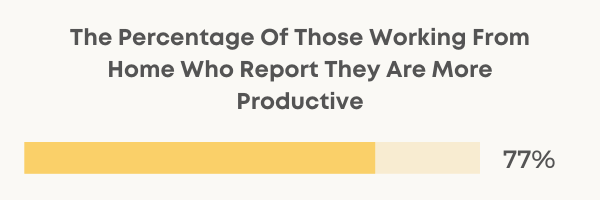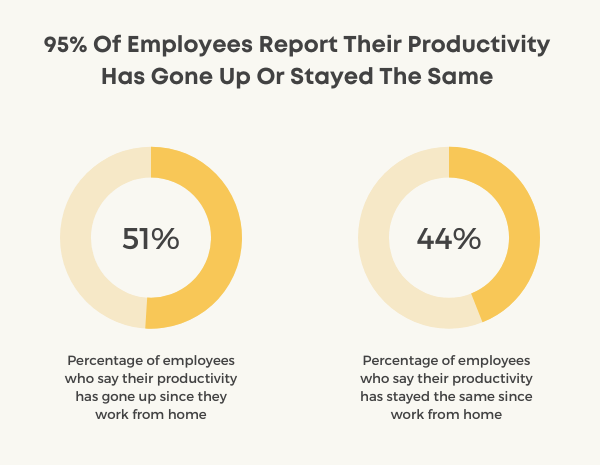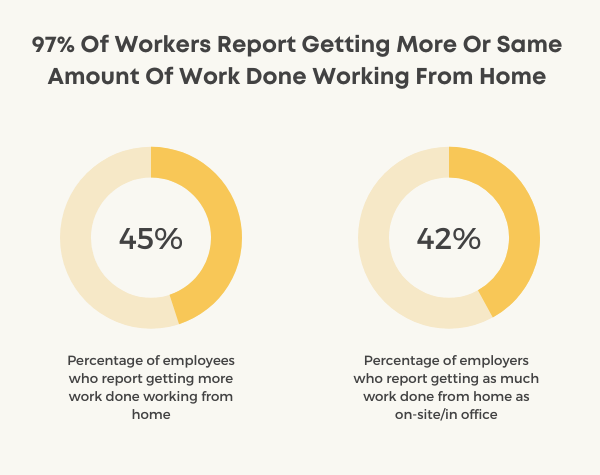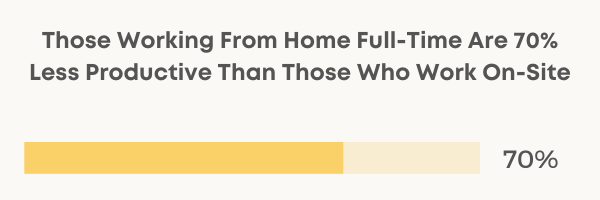Are remote workers more or less productive than on-site workers?
Well, it depends! However, there is enough information that promises that remote work might be influencing workers’ productivity positively.
How about the same workers who switched from working in the office to working from home? Are they more or less productive? Is there any change in productivity at all?
Keep reading this article and you will learn about all the important remote working productivity statistics.
Editor’s Pick Of Working From Home Productivity Statistics
- 77% of employees are more productive working from home.
- There is a 32% increase in performance when working from home.
- 94% report increased or the same level of productivity.
- 78% of employers expected a negative effect on productivity.
- Employees are 13% more productive when working from home.
- 30% of those working from home do more work in less time.
- Productivity will be boosted by 46% thanks to technology.
- Average labor productivity increased by 1.8% since COVID.
33 Remote Working Productivity Statistics
1. 77% of remote workers report they are more productive working from home.
Compared to working on-site, remote workers say they are more productive since working from home. According to statistics about working from home productivity, 77% of workers said they are more productive when they work from home than in the workplace. This could be possible because they do not have workplace distractions to stop them from getting work done.
Source: CoSo Cloud


2. Due to fewer distractions, 75% of remote workers are more productive when working from home.
No long commutes, no colleagues, pointless meetings, and loud chatter in the office are only some of the distractions in the workplace employees encounter. Once they work from home and those distractions are not a problem, 75% of remote workers become more productive, according to FlexJobs study about working from home productivity.
Source: FlexJobs
3. 22.5% of hiring managers said productivity has decreased since employees are working from home.
Since employees started working from home in 2020, according to 22.5% of hiring managers, their productivity has gone down. On the other hand, according to the same research data, 32.2% of hiring managers reported an increase in employees’ productivity.
Source: Upwork


4. When able to work from home, employees’ performance is boosted by 22%.
According to a study by Stanford, employees see a 22% boost in performance when they work from home, compared to on-site.
Source: Stanford
5. Out of 800 surveyed employers, 94% reported employees are more productive since they started working from home.
Mercer surveyed 800 employers and 94% of them said that their employees have become more productive since they were sent to work from home. Out of those, 67% said employees’ productivity was on the same level as when on-site, and 27% reported higher levels of productivity.
Source: Mercer
6. 51% of employees say productivity has gone up and 44% say it has stayed the same since they started working from home.
Altogether, 95% of those who switched to working from home report that their productivity has gone up or stayed the same. In comparison, that means that only 5% report a decrease in working-from-home productivity.
Source: FlexJobs


7. 68% of workers said that a quieter work environment helped them become more productive while working from home.
Compared to the office, workers are finding working from home to be more productive as they have a quieter work environment.
Source: FlexJobs
8. Six in 10 workers said they were more productive working from home than they expected.
On average, productivity when working from home was 7% higher than workers expected. If work from home continues, it could increase the overall productivity of employees, according to forecasts and when compared to the state of workers’ productivity pre-pandemic.
Source: WFH Research
9. 78% of employers expected a negative effect of work from home on productivity during the pandemic.
Once the pandemic started and employers had to send their workers to work from home, 78% of them expected it to harm productivity, according to COVID remote work statistics.
Source: World Economic Forum


10. The most effective way for staying productive for 37% of workers is taking regular breaks.
When asked how to stay productive, 37% of workers said that taking regular breaks helps them.
Source: Airtasker
11. For 33% of workers, the best way to stay productive is to have set working hours.
Just like some find it helpful to take regular breaks when working, others claim that having set working hours is what helps to keep them on track and get more work done.
Source: Airtasker
12. To achieve maximum productivity, 86% of workers prefer it when they work alone.
While loneliness, in the long run, is a big problem for remote workers, it is a good choice for staying productive while working from home. As colleagues can distract workers from getting work done, many prefer to work alone from home where they can focus on their tasks and stay productive.
Source: SurePayroll
13. When workers want to get something done, 49% of them prefer to work from home.
This statistic just shows how workers associate working from home with productivity. However, if they had no choice to work from home when they really have to get something done, 26% chose the office as their second choice for getting the task done.
Source: FlexJobs
14. Those who work from home at least one day a month are 24% more likely to be productive and happy.
Remote work is the most sought-after work benefit, as everyone wants to have flexible hours so they can enjoy their life outside of work, too. According to working from home productivity statistics, those who work from home at least once a month are 24% more likely to be productive. Along with productivity, the perk of working from is also going to make them happier and more satisfied with their job.
Source: Owl Labs


15. Workers are two times more likely to be engaged when they have the technology and materials when working from home.
This is important, as workers who feel engaged at work will also show higher levels of performance, aka they will be more productive. When working from home, workers will feel engaged and be more productive if they have the technology, tools, and materials needed to get their work done.
Source: Quantum Workplace
16. Research found that employees who were 13% more productive when working from home input nearly a whole extra day of work per week.
A Stanford research compared remote workers with those working on-site and found that remote workers were 13% more productive than on-site workers. By being 13% more productive, remote workers scored nearly a whole extra day of work per week.
Source: Stanford
17. 45% of working professionals are working more from home.
Since working from home, 45% of working professionals say they have been getting more work done. In comparison, 42% say they are doing the same amount of work as they do on-site, and 13% less work.
Source: Buffer


18. The least experienced workers are the most likely to be less productive when working from home (32%).
Compared to 23% of those who have work experience but could struggle with productivity when working from home, 32% of workers who have the least experience could also struggle with productivity when working from home and they might actually benefit more from working in the office.
Source: PwC
19. 52% of executives say that the average productivity of employees has improved since working from home.
It is not only employees who are reporting their boost in productivity. Over half of their employers and executives (52%) also say that the average productivity of employees has gone up.
Source: PwC
20. 77% of remote workers show increased productivity, with 30% doing more work in less time and 24% doing more work in the same time slot.
Not only are remote workers more productive than on-site workers, but 30% of them also get more work done in less time, according to work from home statistics.
Source: ConnectSolutions
21. 75% of productivity boost is possible thanks to the reduction of commuting to work.
Researchers believe that productivity is at a higher level at home due to no commute to work. That being said, if we were to eliminate commuting as a factor, there would be a 1% increase in productivity when working from home, compared to pre-pandemic levels.
Source: Chicago Booth Review


22. Those working from home spent 35% of their saved commute time on work.
When working from home means there is no reason to take a long commute to work, it also means more things get done at work. How? According to working from home statistics, those working from home are more productive as 35% of their saved commute time is spent on getting work done.
Source: Becker Friedman Institute
23. Remote work technology will boost productivity by 46% by the end of the pandemic.
The more remote work technology spreads in industries and different parts of the world, the higher the level of productivity working from home will be, compared to pre-pandemic.
Source: Rutgers
24. Workers with boring tasks perform better in office settings than at home.
According to a 2021 study, home distractions could decrease the productivity of those working from home who have to deal with boring tasks. On the other hand, when work is more creative, those working from home perform better than those working in the office.
Source: Journal Of Economic Behavior & Organization
25. Those who work 8 hours a day from home are 70% less productive than those who don’t.
According to working from home productivity statistics data, the more hours that remote workers work from home, the less productive they are. Those working full-time from home turned out to be 70% less productive than those working from the office, according to one study from 2019.
Source: New Technology, Work And Employment


26. Since March 2020, a 47% increase in productivity is reported, compared to March and April 2019.
A Prodoscore research data shows a productivity growth of 47% when working from home since March 2020, compared to the same period the year before. In the week, those working from home are the most productive on Tuesday, Wednesday, and Thursday.
Source: Prodoscore
27. Employees working from home avoided work 15% less and spent 1.4 more days working each month.
Another study from March 2020, when the pandemic broke out, shows that those working from home were more productive compared to working on-site.
Source: Airtasker
28. 79% of those who work from home report focus as one of the benefits of working from home.
As almost 8 in 10 remote workers who work from home can focus better than they can in an office, this leads to an increase in p productivity.
Source: Owl Labs
29. The most engaged workers work remotely 60% to 80% of the time.
Productivity increases by 15% when employees are motivated and engaged, according to research. And those who are the most motivated are also those who spend most of their time working remotely.
Source: Gallup
30. Productivity can be boosted by 4.8% from one day of work from home per week.
If employees work from home one day a week, a study finds that their productivity will be boosted by 4.8%.
Source: Becker Friedman Institute
31. During the pandemic, labor productivity increased by 1.8%.
Compared to pre-pandemic, when labor productivity increased by 1.4% on average (between 2005 and 2019), it increased by 1.8% between the second quarter of 2020 and the second quarter of 2021.
Source: US Bureau of Labor Statistics


32. 74% of employees report the same level of productivity or an increase in it on individual tasks since they started working from home.
When it comes to individual tasks, three-quarters of employees say that their level of productivity stayed the same or increased. These tasks involve writing presentations, analyzing data, and more.
Source: Boston Consulting Group
33. Around 55% of workers said they were less productive and less engaged when working from home.
According to research data by 451, 55% were both less productive and less engaged when they started working from home. On the other hand, 35% felt more productive but less engaged. Overall, only 11% felt more productive and more engaged while working from home.
Source: 451
Final Verdict
To sum everything up, work from home productivity statistics data show a mix of increased and decreased productivity due to remote work, such as working from home. This can be explained as different individuals having different preferences as to where they like to work. Other than that, some other distractions from home might be influencing their productivity positively or negatively when working from home. There is still space for improvement, according to remote work statistics.

































Find Us on Socials